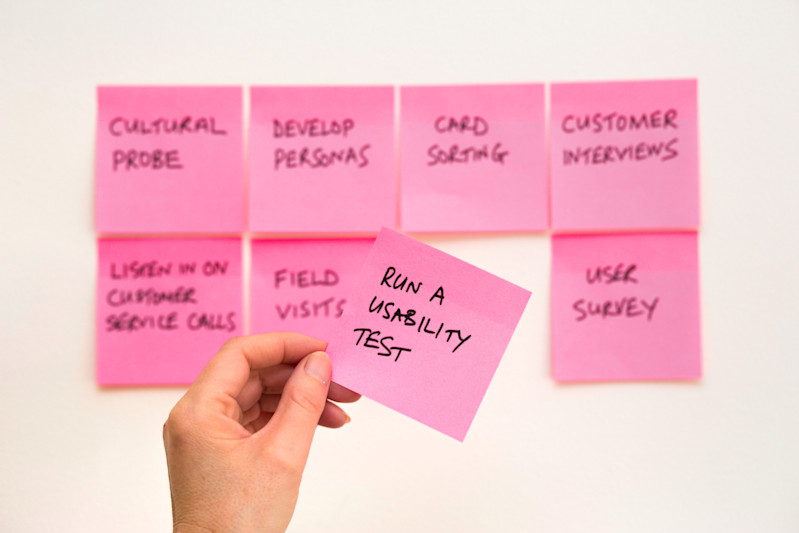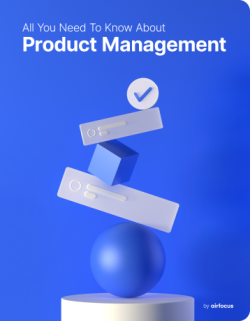
When we think about products that are bad for the environment, we think of private jets, gas-guzzling diesel vehicles, and single-use plastic bottles. It feels counter-intuitive to think of anything digital having a negative physical impact on the planet –– it’s not even tangible, after all!
But the digital world actually has a sizeable carbon footprint. Our personal and work gadgets, the internet, and the systems supporting them account for 3.7% of all greenhouse emissions. Need to put that into perspective? It’s about the same as the airline industry. What’s worse is that these emissions are likely to double by 2025. It makes sense: our digital transformations are ramping up, and so too are our emissions.
This means that in 2022, and in the tech world specifically, sustainable product design is more important than ever. And yet, sustainability is a top-two product development priority for less than half of tech product leaders. Surely that number needs to be a little higher?
Unfortunately, there are some roadblocks that are stopping tech developers from being able to realize their full, eco-friendly potential. Without cemented processes, buy-in from C-suite and stakeholders, and a gold-standard CX design, it’s not easy to just suddenly produce sustainable software overnight.
It’s going to require a team effort. Sustainability in product design is not just possible, but it’s definitely in our future. The question is about just how soon we can get there.
First, we must highlight the problems, and make sure we’re all on the same page.
What do we mean by sustainability in product design?
Let’s quickly set the scene.
Sustainable product design is about taking a more considered approach when it comes to creating a new product, keeping the environmental, social, and economic impacts in mind for the whole process.
Creating a sustainable product means prioritizing the needs of people and the planet without compromising on quality. Sustainable products are a win on all fronts: they’re better for the planet, better for the user, and can lead to more business… and therefore, profits.
A recent Nielsen survey found that two-thirds of respondents were willing to pay a higher price for products that are explicitly more sustainable than similar ones on the market. By making sustainability a core tenet of their product design, brands can signal their focus on sustainability as a whole.
When defining sustainable digital products, it’s essentially the same concept. Sustainable software engineering doesn’t just consider environmental impacts as an afterthought –it’s included as an aspect essential to the software design.
When designing sustainable digital products, the goal is to minimize the impact that the software, the hardware, and the infrastructure that hosts it, have on the environment. There’s no one-size-fits-all formula for designing and creating sustainable software, though. Every tech product is different, so every approach will have to be tailored.

Three main challenges in sustainable digital product design
If it were easy to create sustainable digital products, we wouldn’t even be talking about it — we’d simply be doing it. Of course, there will be some speed bumps to overcome, which project managers should keep in mind from the beginning.
Sustainability in product design problem #1: Software needs to work and meet user expectations
Obviously, your software needs to work. That’s a given. You can’t sacrifice user experience for a more environmentally-friendly product. All that will do is deter your customers and send them off to your competitors.
So whatever we do in order to design digital products more sustainably, it can't come at the expense of UX, usability, and value to the end user.
In most cases, this will mean more team hours, more beta testing, more debugging, and some creative thinking. The reality is, creating software that is explicitly more sustainable is probably going to cost more money.
This begs the question: Are consumers ready to pay more for more sustainable software options? We know that in industries like fashion and lifestyle, certain segments of them are –– but what about when it comes to tech and SaaS?
Sustainability in product design problem #2: Lack of sustainable solutions
One of the main barriers keeping tech companies from fully embracing more sustainable options is simply the lack of solutions.
Yes, we have ways to access data that helps us measure the sustainability of our products. For example, life-cycle assessment accounting, which tracks the environmental impact of a product from conception to retirement. Carbon footprint analytics can be included in software, so customers can assess the carbon intensity of their apps and experiences.
But as of yet, there's no defined way of building software sustainably — at least not to the extent we've seen in other sectors, like fashion, food and beverage, and even other areas of design. Without a roadmap to follow, it’s hard to make sure we’re all on the same page.
When a fashion label creates a new collection, they can source their fibers ethically, pay textile workers fair wages, use low-emission transport, create eco-friendly shopfronts, etc. There’s a set standard for how to be sustainable (and how not to be).
That simply does not yet exist in the world of software design.
Sustainability in product design problem #3: Struggle to get buy-in
As a society, we all know that we need to be more eco-friendly. Sustainability is a rising trend, across almost every consumer area. But the tech industry is trailing behind.
While the business case for sustainable design is building, pioneering product managers and product teams may still struggle to get the full support of the team. After all, it'll cost money and time to switch all your processes to more sustainable practices!
According to a McKinsey survey, while customers and shareholders are demanding more sustainable products, it’s not yet considered a strategic investment for tech product leaders. Yes, it brings value to a product –– but requires new techniques and investments that are hard to see as “worth it”.
Examples and strategies of sustainable digital design
Of course, despite the struggles, there are still pioneers out there championing the need for sustainable digital design. We can look to these examples as inspiration to work toward –– or even use them as proof of concept when trying to convince team members to get aboard the sustainability train!

Sustainable web design
Sustainable web design focuses on really fine-tuning a customer’s experience on the page. Walk through the customer journey: how fast can they find what they’re looking for, how many large files are needed to load or download, and is content optimized across platforms and different bandwidth speeds?
Another key thing to consider is your hosting provider –– are they using clean energy sources?
What are the principles of a low-impact site?
Do not load any images before they are actively requested by the user.
Minimize the power consumption on the user’s device by limiting video, 3D animation, and scripts.
Inform the user of the impact of their browsing behavior.
Do not make use of videos unless absolutely necessary.
Store data locally on the user’s device to minimize data transfer.
Compress all data to the greatest extent possible.
Load only the most crucial programming scripts, frameworks, and cookies.
Limit the amount of light emitted by the screen, by using fewer colors.
Optimize and limit the use of custom fonts.
Some examples of companies excelling in their sustainable website design:
This online photo hosting site gives users a secure place to store all their photos –– freeing up space on their hard drive and limiting energy consumption.
Danish underwear brand Organic Basics recently redesigned its site to be far more “low-impact”. Data transfer on their site is about 70% lower than on traditional shopping sites, thanks to their monochromatic design and lack of large media files.
Organic Basics also decided to make the source code of their Low Impact Website publicly available, for companies wanting to make their own websites greener.
Sustainable app design
When designing an app, just like with a website, there are a number of key factors to consider when it comes to sustainability.
Some things to keep in mind:
Delete what you don't need so that you’re not wasting storage space. This allows product teams to really focus on the core of the user experience, so it's a win, win anyway!
Build a Minimum Viable Product (MVP) to start with. This will help ensure you don’t add random data-hungry or bloated features unless it’s otherwise confirmed that they’re needed.
Choose a green host to reduce your carbon footprint. Though it might seem like a hassle to switch providers, it’s worth it in the long run. For apps that need APIs or a server, check out the Green Web Foundation which has a roundup of 500+ green hosting companies found around the world.
Limit auto-load for photos, and focus on a text-heavy app where possible.
Improve user experience to limit the time people spend navigating around in the app –– streamline the process so they spend less time tapping around and consuming energy.
Implement caching at every level to speed up your app and allow your server to work more efficiently.
Offsetting your carbon footprint
This is one of the easiest ways to be more eco-friendly. While sustainable software development takes time, effort, and money, finding ways to offset your carbon footprint is a relatively easy way to lessen your impact on the environment.
Not only can companies do their part in reconciling their own emissions, but they can go a step further and offer customers a chance to do so too.
A perfect example of this is when you’re booking a plane ticket –– more often than not you’ll be offered the option to add a few dollars to your total to offset the carbon emissions of your flight.
This concept can be introduced in the tech industry too. Take TreeClicks for example. It’s an innovative Chrome extension that plants trees when a customer shops at one of their 50,000+ online partners. The customer pays the same price, but TreeClicks receives a fee for the referral, which they use to plant trees.
Is there a way you can introduce similar measures into your software design? Perhaps customers can opt-in to a slightly higher subscription fee in return for their monthly carbon usage being offset.

Sustainable brand extensions
Building environmentally-friendly tech isn’t always just about the products you’re creating. In some instances, brands can create extensions around their products that feed into their sustainability ethos.
One example is Lush Labs. The skincare brand with a major focus on sustainability launched an app called Lush Labs, where they workshop new products with consumers. Anyone can download the app and get a sneak peek at the new items in development. Lush uses the app as a place for two-way conversation: they solicit feedback from consumers and use it to tailor their brand experience and products.
As a software company that is trying to promote more ethical and sustainable practices, it’s possible to introduce new brand extensions that remind your customers where your priorities lie. Establish yourself as a company that’s passionate about sustainability and that will go above and beyond to reduce your carbon footprint.
By defining yourself in this way, customers will know what to expect with your products –and perhaps be comfortable with paying a little extra for that sustainable aspect. Customer feedback is an essential part of the ongoing development of your product, so why not use it to help shape sustainability in product design too?
>> Read our guide about customer feedback management here.
airfocus knows that the software development industry is ever-changing and evolving. As soon as you’re on top of one tech advancement or industry hot topic, another sprouts up. That’s why we put together our Product First report, to usher in the new era of product management.
We surveyed over 300 product professionals to identify the key challenges faced by product teams… and their expected target benefits from dedicated product management technology. It’s a fascinating look into tech product design, including:
The rising profile of product teams in the modern era
The prominent challenges of product managers
And the need for modular, structured product management.
This research by airfocus and Onepoll aims to give you an in-depth look at challenges including the ones we’ve covered in this article, as well as the features that are expected from product tools to help perform tasks more efficiently. You can download the report for free.

Tomas Prochazka

Read also



Experience the new way of doing product management

Experience the new way of doing product management




